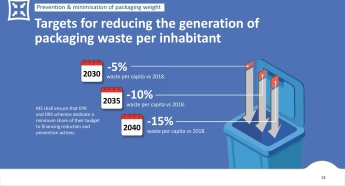The new Packaging and Packaging Waste Regulation (PPWR) marks a major change of direction in the European Union’s packaging policy. In this blog, we zoom in on one of the main pillars: prevention of packaging waste, as laid down in Article 43 of the PPWR.

Reduction targets per Member State
Until now, the main focus of European packaging policy has been on selective collection and recycling. But recycling alone is not enough. The PPWR makes it clear that producing less packaging is the first step in the waste hierarchy. Member States must reduce per capita packaging waste relative to the 2018 baseline year by:
- 5% by 2030
- 10% by 2035
- 15% by 2040
The PPWR contains basic rules that apply to all EU countries. If a country realises that it is in danger of missing the reduction targets, it can take extra measures in time to meet the targets. Examples might be extra market bans or reuse quotas higher than the EU minimum.

Minimising packaging weight and volume
For businesses, this means a fundamental review of their packaging strategies. The recyclability of packaging isn’t the only consideration any more: the necessity and usefulness of packaging also matters. These questions take centre stage:
- Is this packaging really necessary?
- Can the product be presented for sale in refillable or reusable packaging?
- Can packaging volume be reduced without affecting product quality or safety?
The PPWR requires businesses to reduce their packaging to the bare essentials by 1 January 2030: as little material as possible without compromising safety, hygiene or convenience for consumers.
By 2027, harmonised European standards will be developed that clarify when packaging is no heavier or larger than necessary, and how to prove this as a business.
Waiting until 2030 isn’t an option, though: from 12 August 2026 you must be able to show that you are avoiding unnecessary or excessive packaging and gradually bringing your packaging designs into line with the new requirements.

Tackling excessive packaging
The PPWR explicitly prohibits the use of excessive packaging, such as unnecessary double packaging or oversized boxes with lots of air. Such practices will no longer be allowed. The focus is on efficiency and proportionality.
Empty space in grouped packaging, transport packaging or e-commerce packaging that protects the product during shipment to the consumer must be less than 50% – and filler material counts as empty space. The calculation method for this hasn’t yet been published.
An exception is provided for:
- Sales packaging also used as e-commerce packaging.
- Reusable packaging within a reuse system.
As a business, what can you do today?
- Carry out a packaging audit: identify where you can save on materials.
- Integrate packaging reduction into all your processes, including development and purchasing.
- Work with your supply chain partners: from producers to retailers, everyone plays a role.
- Inform your customers: getting consumers involved is essential for behavioural change.
How can Fost Plus help you?
Our Reduce & Reuse Team will guide your company in reducing your packaging. By investing in circular solutions today, you'll not only build a more sustainable model but also a future-proof business. Contact our team.
